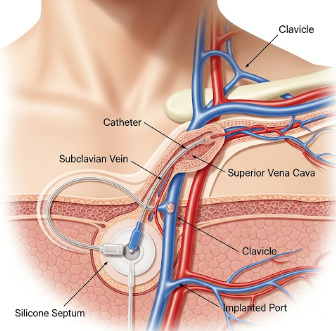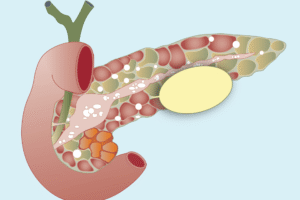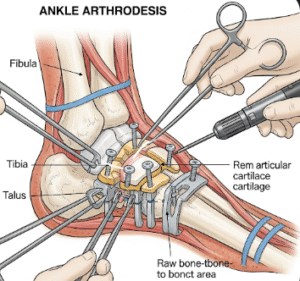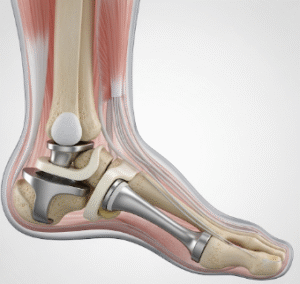Overview
An implanted port, also called a Port-a-Cath, is a medical device surgically placed under the skin to provide long-term access to a vein. It is commonly used for patients requiring frequent intravenous treatments such as chemotherapy, antibiotics, or nutrition.
South Korea is renowned for expert interventional radiologists and surgeons, modern surgical facilities, and high-quality post-operative care, making it a preferred destination for safe, minimally invasive port implantation and management.
What is an Implanted Port?
An implanted port is a small medical device consisting of a reservoir (port) connected to a catheter that is inserted into a large central vein, usually near the chest.
Key features:
- Subcutaneous placement → The port sits under the skin for a discreet and low-maintenance setup
- Catheter connection to a central vein → Allows repeated access without repeated needle sticks
- Durable and long-term → Can remain in place for months to years depending on treatment needs
Indications include:
- Chemotherapy for cancer patients
- Long-term intravenous antibiotic therapy
- Total parenteral nutrition (TPN)
- Frequent blood draws for patients with difficult veins
- Chronic conditions requiring repeated IV therapy
What are the Benefits?
- Minimizes needle sticks → Reduces discomfort and preserves peripheral veins
- Safe for long-term therapy → Designed for months to years of repeated use
- Discreet and low maintenance → Subcutaneous placement keeps port hidden
- Reduced infection risk compared to external catheters
- Enables efficient treatment delivery → Chemotherapy, IV fluids, or blood draws can be performed quickly
- Expert care in Korea → High success rate with minimal complications due to advanced techniques
Procedure Details
1) How should I prepare for Implanted Port placement?
- Preoperative evaluation → Blood tests, imaging, and medical history review
- Medication review → Discuss blood thinners and chronic medications with your physician
- Fasting → Typically 6–8 hours prior to procedure if sedation is used
- Pre-procedure consultation → Discuss type of port, anesthesia, placement location, and aftercare
- Lifestyle adjustments → Avoid smoking and maintain hydration
2) What happens during the procedure?
- Anesthesia → Local anesthesia with sedation or general anesthesia in select cases
- Surgical steps →
- Small incision made near the chest or upper arm
- Port reservoir placed under the skin
- Catheter threaded into a large central vein (usually the superior vena cava)
- Port secured and incision closed with sutures or adhesive
- Duration → 30–60 minutes
- Monitoring → Vital signs monitored throughout; imaging (fluoroscopy or ultrasound) used to confirm placement
3) What happens after Implanted Port placement?
- Immediate recovery → Mild pain or swelling at the incision site, usually managed with analgesics
- Hospital stay → Often outpatient; patients can go home the same day
- Activity restrictions → Avoid strenuous upper-body activity for 1–2 weeks
- Port care → Regular flushing with saline or heparin to prevent blockage
- Follow-up visits → Wound check, port function assessment, and education on maintenance
Risks / Benefits
Risks
- ➤ Infection at the port site or bloodstream infection
- ➤ Blood clot formation in the catheter or central vein
- ➤ Catheter blockage or migration
- ➤ Bleeding, bruising, or swelling at the insertion site
- ➤ Rare injury to surrounding structures (lung, artery, or nerve)
- ➤ Skin irritation or discomfort over the port
Benefits
- ➤ Long-term, reliable venous access for repeated therapy
- ➤ Reduces discomfort from multiple needle sticks
- ➤ Minimizes infection risk compared to external catheters
- ➤ Discreet and low-maintenance device
- ➤ Expert placement and monitoring in Korea ensures safety and longevity
Recovery and Outlook
- Immediate recovery → Mild soreness or swelling; normal activities resumed gradually
- Short-term care → Keep incision clean and dry; monitor for infection
- Long-term maintenance → Regular flushing, routine dressing changes, and port checks
- Duration → Can remain in place for months to years depending on therapy needs
- Lifestyle → Patients can continue most daily activities with minor adjustments
- Long-term outlook → Safe, efficient, and reliable access for long-term IV therapy with minimal complications
South Korea provides comprehensive post-operative care, including port maintenance training, complication monitoring, and long-term support.
When To Call the Doctor
Contact your physician immediately if you notice:
- ⚠️ Redness, swelling, or pus at the port site
- ⚠️ Fever or chills indicating infection
- ⚠️ Difficulty flushing the port or unusual resistance during infusion
- ⚠️ Sudden pain, bleeding, or swelling in the chest or arm
- ⚠️ Shortness of breath or chest discomfort
Best Korea Option / Process
South Korea is a leading destination for Implanted Port placement due to:
- Expert interventional radiologists and surgeons
- Advanced imaging-guided placement techniques for precision and safety
- Minimal hospital stay and fast recovery
- Comprehensive aftercare and patient education for port maintenance
- International patient services → Coordination, translation, and follow-up support
Top Hospitals for Implanted Port in Korea:
- Asan Medical Center, Seoul – State-of-the-art port placement and post-operative care
- Samsung Medical Center – Advanced imaging-guided implantation and maintenance
- Seoul National University Hospital (SNUH) – Expert interventional radiology and oncology integration
- Yonsei Severance Hospital – Multidisciplinary care with long-term follow-up
👉 For patients requiring long-term intravenous therapy, Implanted Port placement in Korea offers a safe, reliable, and minimally invasive solution with expert surgical care and comprehensive aftercare.













